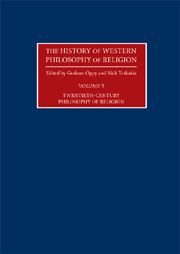Book contents
- Frontmatter
- Contents
- Editorial Introduction
- Contributors
- 1 Twentieth-Century Philosophy of Religion: An Introduction
- 2 William James
- 3 Henri Bergson
- 4 John Dewey
- 5 Alfred North Whitehead and Charles Hartshorne
- 6 Bertrand Russell
- 7 Max Scheler
- 8 Martin Buber
- 9 Jacques Maritain
- 10 Karl Jaspers
- 11 Paul Tillich
- 12 Karl Barth
- 13 Ludwig Wittgenstein
- 14 Martin Heidegger
- 15 Emmanuel Levinas
- 16 Simone Weil
- 17 A. J. Ayer
- 18 William P. Alston
- 19 John Hick
- 20 Mary Daly
- 21 Jacques Derrida
- 22 Alvin Plantinga
- 23 Richard Swinburne
- 24 Late-Twentieth-Century Atheism
- Chronology
- Bibliography
- Index
13 - Ludwig Wittgenstein
- Frontmatter
- Contents
- Editorial Introduction
- Contributors
- 1 Twentieth-Century Philosophy of Religion: An Introduction
- 2 William James
- 3 Henri Bergson
- 4 John Dewey
- 5 Alfred North Whitehead and Charles Hartshorne
- 6 Bertrand Russell
- 7 Max Scheler
- 8 Martin Buber
- 9 Jacques Maritain
- 10 Karl Jaspers
- 11 Paul Tillich
- 12 Karl Barth
- 13 Ludwig Wittgenstein
- 14 Martin Heidegger
- 15 Emmanuel Levinas
- 16 Simone Weil
- 17 A. J. Ayer
- 18 William P. Alston
- 19 John Hick
- 20 Mary Daly
- 21 Jacques Derrida
- 22 Alvin Plantinga
- 23 Richard Swinburne
- 24 Late-Twentieth-Century Atheism
- Chronology
- Bibliography
- Index
Summary
“Tell them I've had a wonderful life.” These were Wittgenstein's last words, spoken on his deathbed in 1951 (Monk 1991: 579). Certainly, Wittgenstein had a remarkable life: one devoted not just to philosophy, but to a relentless pursuit of truthfulness, to a purity of heart and mind. Right until the very end Wittgenstein was working on remarks that have come to be known as On Certainty, but the only piece of writing completed and published during his lifetime remains his early masterpiece, the Tractatus Logico-Philosophicus (hereafter Tractatus). It fell to his literary executors to prepare his immense Nachlass for publication.
The life that ended at Storeys End, Cambridge, began in fin de siècle Vienna on 26 April 1889. Ludwig Josef Johann was the eighth and youngest child of a prominent and wealthy Austrian family of Jewish extraction. The Wittgenstein children grew up in an extraordinary environment: not only did the family itself display considerable musical talent, but their grand home in the Alleegasse was frequented by an assortment of the time's greatest artistic figures, among them Johannes Brahms, Pablo Casals, Gustav Mahler and Bruno Walter. Wittgenstein's sister Margarete was painted by Gustav Klimt, and his brother Paul became a celebrated concert pianist, for whom Ravel, Prokofieff and Strauss wrote concertos. But Ludwig's early life was also overshadowed by tragedy: two of his brothers committed suicide before Ludwig was out of his teens.
- Type
- Chapter
- Information
- The History of Western Philosophy of Religion , pp. 161 - 174Publisher: Acumen PublishingPrint publication year: 2009
- 1
- Cited by

